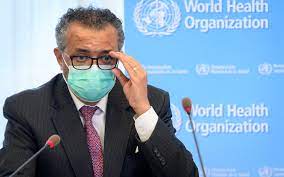The pandemic is far from over, the WHO’s leader insisted on Wednesday, two years after he first used the term to wake the world up to the emerging threat of COVID-19.
The World Health OrganiSation’s director-general Tedros Adhanom Ghebreyesus first described Covid-19 as a pandemic on March 11, 2020.

Two years on, he lamented how the virus was still evolving and surging in some parts of the world.
The WHO declared a public health emergency of international concern – the highest level of alarm in the UN health agency’s regulations – on January 30, 2020, when, outside of China, fewer than 100 cases and no deaths had been reported.
But it was only the use of the word pandemic six weeks on that seemed to shake many countries into action.
“Two years later, more than six million people have died,” Tedros told a press conference, while nearly 444 million cases have been registered.
“Although reported cases and deaths are declining globally, and several countries have lifted restrictions, the pandemic is far from over – and it will not be over anywhere until it’s over everywhere.”
He noted the 46-per cent rise in new cases last week in the WHO’s Western Pacific region, where 3.9 million infections were recorded.
“The virus continues to evolve, and we continue to face major obstacles in distributing vaccines, tests and treatments everywhere they are needed,” Tedros said.
He also sounded a warning on the recent plunge in testing rates, saying it left the planet blind to what Covid-19 was up to.
“WHO is concerned that several countries are drastically reducing testing,” Tedros said.
“This inhibits our ability to see where the virus is, how it’s spreading and how it’s evolving.”
Read Also: COVID: UN Agencies Warn Against Consumption Of Sick, Dead Animals
– Call for vigilance –
The number of fresh cases fell five percent worldwide last week compared to the week before, while the number of deaths dropped eight percent.
However, Maria Van Kerkhove, the WHO’s Covid-19 technical lead, warned that the case rate was certainly an underestimate due to the dramatic drop-off in testing.
“The virus is still spreading at far too intensive a level, three years into this pandemic,” she said.
“Even though we are seeing declining trends… there were still more than 10 million reported cases reported at a global level last week.
“We have to remain vigilant.”
In its weekly update on the spread of the virus, the WHO said earlier that the Omicron variant had “global dominance” over other mutations of the virus.
The WHO said Omicron accounted for 99.7 percent of samples collected in the last 30 days that have been sequenced and uploaded to the GISAID global science initiative.
The WHO says unequal access to COVID-19 vaccines, tests and treatments remain rampant and is prolonging the pandemic.
On jabs, the WHO’s latest figures show 23 countries are yet to fully immunise 10 percent of their populations, while 73 countries are yet to achieve the 40 percent coverage target set for the start of 2022.
Kindly like us on Facebook














